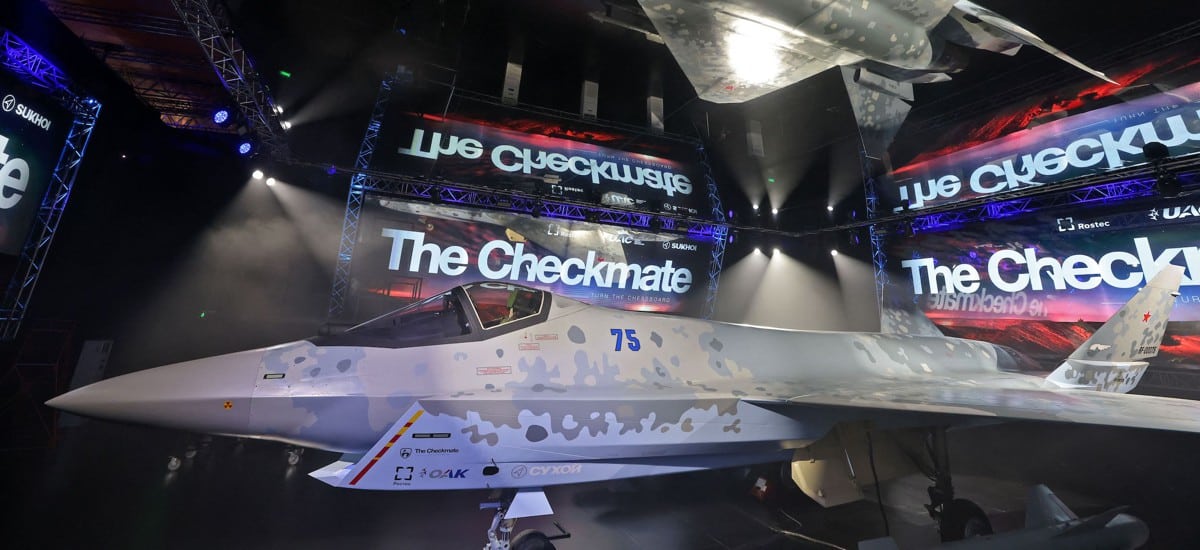Aviation
Su-75 Checkmate Fighter Jet Concept Reveals Major Design Changes for Enhanced Performance

Recently, Russia released the eagerly awaited Su-75 Checkmate, its most recent fighter jet design. With a focus on enhancing performance and stealth abilities, the aircraft has undergone substantial design modifications. The improved aerodynamics and smaller radar cross-section of the aircraft are highlighted in the new concept images, which also show other modifications.
Yury Slyusar, CEO of the company, said the company’s strategies while noting that the Checkmate project makes use of cutting-edge supercomputer technologies. Because of this, the business can begin the flight tests as early as 2024 and drastically cut the prototype construction time.
The new fighter has numerous significant modifications aimed at improving flight performance and stealth capabilities. The nose cone has been sawtooth-patterned to improve aerodynamic qualities while considerably lowering radar cross-section.
Additionally, the wing root form has been modified to optimize airflow and minimize drag, resulting in improved maneuverability and overall efficiency. The flaperon, a control surface positioned on the wing, has been significantly enlarged and extended towards the back of the aircraft. This enhancement increases control authority and allows for precise maneuvering in a variety of flight modes.
One of the key aspects of the Su-75 Checkmate is its stealthy design. The aircraft incorporates a reduced radar cross-section, advanced composite materials, and optimized shaping to minimize its visibility to enemy radars. This stealth capability allows the Su-75 to penetrate hostile airspace with reduced risk of detection, enabling it to carry out precision strikes and other missions with a higher chance of success.
The aft strakes, which are lateral aerodynamic surfaces on the fuselage’s back, have also been expanded. The aircraft’s performance in terms of stability, control, and high-angle-of-attack are improved by these changes, together with the enlarged strake flaps.
These extensive design changes result in an aircraft that has better flight characteristics, superior agility, and increased stealth capabilities. This fighter is more maneuverable, effective, and substantially harder to spot in a variety of operational conditions with its sawtooth-treated nose cone, modified wing root form, expanded flaperon, extended aft-strakes, and redesigned vertical stabilizer assembly.
The Su-75 Checkmate is about ready for the next phase of development, which will include flight testing and evaluation. Its introduction demonstrates Russia’s dedication to innovations in military aviation as well as the country’s ambition to compete with other top manufacturers in the global fighter jet sector.

Aviation
Airbus Enhances A350 Cabin with 10-Abreast Seating

Airbus has announced a new partnership with Jiatai Aircraft Equipment, a Chinese aircraft seating manufacturer, to supply upgraded economy-class seats for the A350 widebody series.
This collaboration, unveiled at the 2024 Airshow China, focuses on developing a newly designed economy seat tailored for the A350‘s New Production Standard (NPS) cabin.
One of the key features of the NPS cabin is the ability to accommodate 17-inch wide economy seats, compared to the previous 16.5-inch wide seats that airlines were limited to in the A350’s earlier configurations.
British Airways Unveils Its Brand-New First Class Cabin for the Airbus A380
This change is made possible by the expanded space in the NPS cabin, which is 35 inches longer and 4 inches wider than the previous version. This extra space is achieved by slightly moving the cockpit wall forward and shifting the rear pressure bulkhead back by one frame.
The wider cabin allows airlines to add up to 30 extra economy seats without compromising comfort. For airlines opting for a 3-4-3 seating layout, the 17-inch wide seats are an excellent choice for a more comfortable passenger experience. However, some airlines, such as Iberia, may choose to retain a 9-abreast layout with wider seats for added comfort.
The NPS cabin also offers enhanced flexibility for airline operators. One major advantage is the ability to easily switch between a 9-abreast and 10-abreast seating configuration without requiring significant downtime for aircraft reconfiguration. Airlines can use the same seat rails, tracks, and IFE interfaces, making the transition smoother and quicker.
Etihad Airways Unveils 10 Exciting New Routes for 2025
In addition, the design of the floor attachments and air-conditioning systems has been optimized for 10-abreast seating, meaning airlines can upgrade their cabins without needing to make substantial modifications to the aircraft’s structure.
Though it’s still unclear when Jiatai’s economy-class seats will be officially added to the A350’s Buyer Furnished Equipment (BFE) catalogue, the collaboration marks a significant step toward enhancing the A350’s cabin offerings.
With this partnership, Airbus is providing more seating options for airlines, ensuring that they can meet diverse customer needs while improving overall operational efficiency.
-

 Aviation2 months ago
Aviation2 months agoMicrosoft Flight Simulator Raises $3 Million to Bring Back the An-225 Mriya
-

 Airlines2 months ago
Airlines2 months agoQatar Citizens Can Travel to the United States Without a Visa
-

 Aviation2 months ago
Aviation2 months agoQatar Airways bans these new Electronic Devices on plane
-

 Airlines2 months ago
Airlines2 months agoJapan Airlines Rolls Out Free Domestic Flights to International Passengers
-

 Travel2 months ago
Travel2 months agoQatar Airways Launches Four Additional Flights from Amsterdam
-

 Defence2 months ago
Defence2 months agoWhich Country Has the Largest Fleet of Fighter Aircraft?
-

 Airport2 months ago
Airport2 months agoWestern Sydney Airport Welcomes Its First Plane After 6 Years of construction
-

 Airlines4 days ago
Airlines4 days agoDAMAC Air: Dubai’s New Luxury Airline Offers Free Flights for Registration








